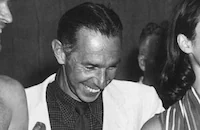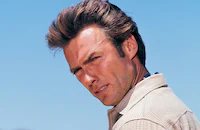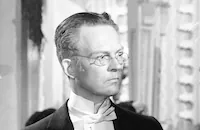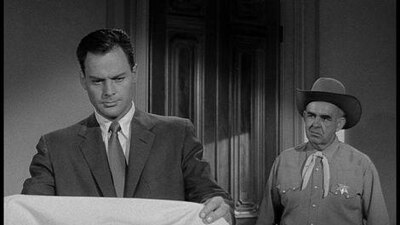Tarantula

Brief Synopsis
Cast & Crew
Jack Arnold
John Agar
Mara Corday
Leo G. Carroll
Nestor Paiva
Ross Elliott
Film Details
Technical Specs

Synopsis
In Desert Rock, Arizona, Sheriff Jack Andrews asks country doctor Matt Hastings to inspect the body of Eric Jacobs, a scientist who has died in the desert outside the laboratory of nutrient biologist Dr. Gerald Deemer. Noting that Jacobs had contracted the rare glandular disease acromegalia, which, over the course of years, causes gigantism, Matt does not believe Deemer's claim that his partner's illness set in only days earlier. Back at his lab, Deemer continues experimenting with a growth-inducing serum, but just after he injects a tarantula, his other lab partner, Paul Lund, who is now deformed, breaks into the lab. Deemer realizes that Lund, like Jacob, has grown crazed after being injected with the serum, and to wreak revenge, Lund injects Deemer and breaks open the animal cages. As the tarantula escapes, a fire starts, destroying Lund and the other animals, and later, Deemer buries Lund in the back. The next day, Matt, still disturbed by the rapid onset of acromegalia in Jacobs, insists on an autoposy, but finds nothing. Matt prepares to visit Deemer's lab to investigate, and along the way bumps into pretty Stephanie "Steve" Clayton, a graduate student who has just arrived in town to serve as Deemer's new assistant. Matt informs her about Jacobs' mysterious death, and takes her to the laboratory, where Deemer, who wants only to create a food synthetic to solve world hunger, shrugs off Matt's questions. Later, the doctor explains to Steve the serum's solution, and the radioactive isotrope that triggers it, to Steve. Over the next few days, Steve marvels at the rapid growth of Deemer's baby rats, but also notes the growing deformities in his hands. One day, Matt drives Steve through the desert, and when they stop to admire the rock formations, the tarantula, now twenty stories tall but hidden behind the rock, causes an avalanche from which the couple barely escapes. When Steve then shows Matt the rats, Deemer, now more deformed and unnaturally enraged by the acromegalia, shouts at her for revealing their experiments. At the same time, Matt is stopped on the road by Jack, who asks him to accompany him to local rancher Andy Andersen's, whose cows have been eaten whole. There, they discover a pool of liquid on the paddock ground. Although Matt takes samples, he can promise no answers. That night, the tarantula returns and devours Andy, while simultaneously, Matt discovers that the liquid is insect venom and calls Deemer to ask about it. Steve answers and admits that she has grown scared of Deemer, who overhears and grabs her. Matt races to the lab, followed by the tarantula. Inside, Deemer has collapsed and Matt, realizing the doctor has acromegalia, revives him and puts him to bed. There, Deemer confesses what has happened to his other associates, stating that he wanted only to complete his experiments before he died. Hearing about the tarantula that escaped, Matt rushes to an entomologist, who confirms that the venom came from a huge spider that has become ferocious and deadly. Meanwhile, the tarantula, still growing, walks across the desert, destroying phone lines, and later grows fascinated by Steve's beauty and stares in through her bedroom window. Matt rounds up the local police and arrives at Deemer's in time to save Steve, but as they drive away, the tarantula tracks them. Along the road, two policemen try to shoot the monster down, but it repels the bullets, prompting Matt to suggest that they call in the Air Force to bomb it. While everyone huddles in the streets as the tarantula approaches menacingly, the pilots arrive and begin dropping napalm bombs. Just before the tarantula can destroy the town, the napalm finally hits it target, and the spider explodes into flames, leaving the town safe.

Director

Jack Arnold
Cast

John Agar

Mara Corday

Leo G. Carroll

Nestor Paiva

Ross Elliott
Edwin Rand
Raymond Bailey
Hank Patterson
Bert Holland
Steve Darrell

Clint Eastwood
Jane Howard
Billy Wayne
Dee Carroll
Tom London
Edgar Dearing
James J. Hyland
Stuart Wade
Vernon Rich
Bob Nelson
Ray Quinn
Ed Parker
Bing Russell
Robert R. Stephenson

Don Dillaway

Bud Wolfe
Jack Stoney
Rusty Wescoatt
Crew
William Alland
Jack Arnold
Martin Berkeley
Leslie I. Carey
Robert M. Fresco
Robert M. Fresco
Russell A. Gausman
Joseph Gershenson
Alexander Golitzen
Ruby R. Levitt
William M. Morgan
George Robinson
Ed Sandlin
Frank Shaw
Joe Sikorski
Joan St. Oegger
Clifford Stine
Alfred Sweeney
Bud Westmore
Frank Wilkinson

Photo Collections
Videos
Movie Clip



Hosted Intro
Film Details
Technical Specs

Articles
Tarantula
Insects and reptiles were the frequent objects of transformation in these films as moviegoers kept flocking to theaters displaying titles like The Giant Gila Monster (1959), Beginning of the End (1957), and The Deadly Mantis (1957). The original film that kicked the entire craze off was 1954's Them!, a surprise hit from Warner Brothers in which New Mexico atomic bomb tests create giant subterranean ants that feed on the nearby human populace.
Not to be outdone, Universal Pictures (going under the banner of Universal-International, which it dropped in 1962 when it was taken over by MCA) entered the fray one year after Them! with its own giant arachnid movie, Tarantula, which is now often regarded as one of the high points of the killer bug cycle. The film (which doesn't feature an actual nuclear factor in its story but fits within the cycle nonetheless) is a textbook example of many of Universal's talents in the field, particularly stalwart director Jack Arnold, who had already proven himself on the studio's It Came from Outer Space (1953), Creature from the Black Lagoon (1954), and Revenge of the Creature (1955) and would go on to direct one of the decade's most enduring science fiction classics in 1957, Universal's The Incredible Shrinking Man.
Though it shares a desert setting with Them!, Tarantula distinguishes itself immediately from its predecessor by focusing on a single monstrous threat rather than a horde of mutated monsters. The titular beast is created through experiments at the Arizona laboratory of Professor Deemer (Leo G. Carroll), who is trying to increase the size of food to stave off an impending shortage crisis. In the process, Deemer himself is injected with his serum while a tarantula, also subjected to the experiment, breaks loose and begins to grow exponentially. Stymied by a doubting sheriff (Nestor Paiva), the heroic couple of Dr. Matt Hastings (John Agar) and Stephanie Clayton (Mara Corday) race against time to stop the titanic tarantula before the entire town is destroyed.
One of the more beloved '50s B-movie heroes, John Agar began working onscreen in 1948 and had already starred in director Arnold's Revenge of the Creature, which also shares Tarantula's most noteworthy bit player, a very young Clint Eastwood. Thanks to the success of this film, Agar became an in-demand foe for a variety of creatures or even an occasional monster himself, including such films as The Mole People (1956), Daughter of Dr. Jekyll (1957), Attack of the Puppet People (1958), and his most indelible performance as the cackling possessed lead in the cult classic, The Brain from Planet Arous (1957). He remained busy in both films and television well into the 1990s and provided a memorable cameo during the climax of the 1976 version of King Kong. Agar himself regarded Tarantula as one of his better films from the period and gave a great deal of credit to its producer, William Alland, who oversaw most of the Jack Arnold-directed features at Universal and even appeared as the character Jerry Thompson in Orson Welles' Citizen Kane (1941). When speaking with monster expert Tom Weaver, Agar felt Alland "was the one who came up with some of the ideas and he produced the films... Those pictures, whether Universal wants to admit it or not, were moneymakers... I also heard that Tarantula was one of the top grossers of 1955; what they probably meant was that it was a top moneymaker in terms of what it cost and what it brought in, but I had heard that it was Number 5 in 1955."
Agar's female co-star, Mara Corday, had been working her way up from bit parts in the early '50s and went on to appear in two more monster movies, both in 1957: The Black Scorpion and the gleefully absurd The Giant Claw. Though she officially retired from acting in 1961, she resurfaced four times to appear in colorful character roles for her friend Clint Eastwood in such films as The Gauntlet (1977) and Sudden Impact (1983). She had already worked with Arnold on a western, The Man from Bitter Ridge (1955), and found the director "a prankster... he would tell dirty jokes, and then all of a sudden he'd break into a little dance. He used to be a chorus boy in New York, a little dancer, so he'd do steps. He'd fix your chair so that when you sat on it, you'd almost fall, things like that." While she got along well with Arnold, she did wish that her wardrobe had been more flattering to compete with the attention given to previous Universal damsels in distress like Creature from the Black Lagoon's Julie Adams. "I didn't like the wardrobe," she recalls. "It was really conservative. I thought maybe I could at least wear a negligee for the ending - the whole last part of that show was me running away from this tarantula in a night outfit. But they said, 'Oh, no, not on your life" - I had to wear pajamas, and even a light cover over that! So there was no sex appeal there."
One of the era's most in-demand character actors, Leo G. Carroll enjoyed one of his most iconic roles as the mutating Professor Deemer. Corday recalls him as a "very dignified little Englishman... He had a terrible time with that makeup; he had to have everything sipped through a straw 'cause it was like a mask that he had to wear. It took forever to get it on, so you don't take that off for lunch." Fresh off the TV series of Topper at the time, Carroll had been a busy performer since the mid-1930s and often provided effective supporting roles in Alfred Hitchcock films such as Rebecca (1940), Suspicion (1941), Spellbound (1945), The Paradine Case (1947), and North by Northwest (1959).
As for the actual tarantula itself, the monster was created using a combination of live spiders (guided by blasts of air) with models including cotton-constructed miniature hills, and giant spider leg props covered with hair. Though set in Arizona, Tarantula was shot in California with desert scenes in Apple Valley. Corday remembered the heat reaching 120 degrees, which wreaked havoc with a wax-constructed dental appliance she was wearing to close up a gap between her front teeth. "I would be standing there talking," she recalls, "and then my teeth would melt!"
Tarantula was shot during a period in which films were competing heavily against television for audience attention, and a number of different aspect ratios were being explored beyond the usual square-shaped Academy ratio. Widescreen processes like Cinemascope and Panavision were often trumpeted by studios, while non-anamorphic films were more often shown at medium width with an aspect ratio of 1.85:1. Throughout the decade, Universal dabbled in scope for some of its more prestigious films (like the biopic Man of a Thousand Faces (1957) but composed most of its films to be projected around 1.85:1, with excess space left in the frame so it could be shot at Academy ratio (for theaters still locked into that screen size) and then matted off for more modern theaters with wider screens. Tarantula was shot this way and has always been shown on television and home video full frame with the excess headroom present. However, if you have a widescreen television with a zoom button, you can blow it up with your remote control to fill the screen and get an idea of how many first-run audiences actually saw the film. Don't worry; you'll still see all of the tarantula's rampage either way.
Producer: William Alland
Director: Jack Arnold
Screenplay: Robert M. Fresco, Martin Berkeley (screenplay); Jack Arnold, Robert M. Fresco (story)
Cinematography: George Robinson
Art Direction: Alexander Golitzen, Alfred Sweeney
Music: Herman Stein (uncredited)
Film Editing: William M. Morgan
Cast: John Agar (Dr. Matt Hastings), Mara Corday (Stephanie 'Steve' Clayton), Leo G. Carroll (Prof. Gerald Deemer), Nestor Paiva (Sheriff Jack Andrews), Ross Elliott (Joe Burch), Edwin Rand (Lt. John Nolan), Raymond Bailey (Townsend), Hank Patterson (Josh), Bert Holland (Barney Russell), Steve Darrell (Andy Andersen).
BW-80m.
by Nathaniel Thompson
Sources:
Internet Movie Database (www.imdb.com)
Interviews with B Science Fiction and Horror Movie Makes by Tom Weaver. McFarland, 1988.
It Came from Weaver Five by Tom Weaver. McFarland, 1996.

Tarantula
TCM Remembers - John Agar
Popular b-movie actor John Agar died April 7th at the age of 81. Agar is probably best known as the actor that married Shirley Temple in 1945 but he also appeared alongside John Wayne in several films. Agar soon became a fixture in such films as Tarantula (1955) and The Mole People (1956) and was a cult favorite ever since, something he took in good spirits and seemed to enjoy. In 1972, for instance, the fan magazine Famous Monsters of Filmland mistakenly ran his obituary, a piece that Agar would later happily autograph.
Agar was born January 31, 1921 in Chicago. He had been a sergeant in the Army Air Corps working as a physical trainer when he was hired in 1945 to escort 16-year-old Shirley Temple to a Hollywood party. Agar apparently knew Temple earlier since his sister was a classmate of Temple's. Despite the objections of Temple's mother the two became a couple and were married shortly after. Temple's producer David Selznick asked Agar if he wanted to act but he reportedly replied that one actor in the family was enough. Nevertheless, Selznick paid for acting lessons and signed Agar to a contract.
Agar's first film was the John Ford-directed Fort Apache (1948) also starring Temple. Agar and Temple also both appeared in Adventure in Baltimore (1949) and had a daughter in 1948 but were divorced the following year. Agar married again in 1951 which lasted until his wife's death in 2000. Agar worked in a string of Westerns and war films such as Sands of Iwo Jima (1949), Breakthrough (1950) and She Wore a Yellow Ribbon (1949). Later when pressed for money he began making the films that would establish his reputation beyond the gossip columns: Revenge of the Creature (1955), The Brain from Planet Arous (1957), Invisible Invaders (1959) and the mind-boggling Zontar, the Thing from Venus (1966). The roles became progressively smaller so Agar sold insurance and real estate on the side. When he appeared in the 1988 film Miracle Mile his dialogue supposedly included obscenities which Agar had always refused to use. He showed the director a way to do the scene without that language and that's how it was filmed.
By Lang Thompson
DUDLEY MOORE, 1935-2002
Award-winning actor, comedian and musician Dudley Moore died on March 27th at the age of 66. Moore first gained notice in his native England for ground-breaking stage and TV comedy before later building a Hollywood career. Like many of his peers, he had an amiable, open appeal that was balanced against a sharply satiric edge. Moore could play the confused innocent as well as the crafty schemer and tended to command attention wherever he appeared. Among his four marriages were two actresses: Tuesday Weld and Suzy Kendall.
Moore was born April 19, 1935 in London. As a child, he had a club foot later corrected by years of surgery that often left him recuperating in the hospital alongside critically wounded soldiers. Moore attended Oxford where he earned a degree in musical composition and met future collaborators Peter Cook, Jonathan Miller and Alan Bennett. The four formed the landmark comedy ensemble Beyond the Fringe. Though often merely labelled as a precursor to Monty Python's Flying Circus, Beyond the Fringe was instrumental in the marriage of the piercing, highly educated sense of humor cultivated by Oxbridge graduates to the modern mass media. In this case it was the revue stage and television where Beyond the Fringe first assaulted the astonished minds of Britons. Moore supplied the music and such songs as "The Sadder and Wiser Beaver," "Man Bites God" and "One Leg Too Few." (You can pick up a CD set with much of the stage show. Unfortunately for future historians the BBC commonly erased tapes at this period - why? - so many of the TV episodes are apparently gone forever.)
Moore's first feature film was the 1966 farce The Wrong Box (a Robert Louis Stevenson adaptation) but it was his collaboration with Peter Cook on Bedazzled (1967) that's endured. Unlike its tepid 2000 remake, the original Bedazzled is a wolverine-tough satire of mid-60s culture that hasn't aged a bit: viewers are still as likely to be appalled and entertained at the same time. Moore not only co-wrote the story with Cook but composed the score. Moore appeared in a few more films until starring in 10 (1979). Written and directed by Blake Edwards, this amiable comedy featured Moore (a last-minute replacement for George Segal) caught in a middle-aged crisis and proved popular with both audiences and critics. Moore's career took another turn when his role as a wealthy alcoholic who falls for the proverbial shop girl in Arthur (1981) snagged him an Oscar nomination as Best Actor and a Golden Globe win.
However Moore was never able to build on these successes. He starred in a passable remake of Preston Sturges' Unfaithfully Yours (1984), did another Blake Edwards romantic comedy of moderate interest called Micki + Maude (1984, also a Golden Globe winner for Moore), a misfired sequel to Arthur in 1988 and a few other little-seen films. The highlight of this period must certainly be the 1991 series Orchestra where Moore spars with the wonderfully crusty conductor Georg Solti and leads an orchestra of students in what's certainly some of the most delightful television ever made.
By Lang Thompson
TCM Remembers - John Agar
Quotes
Trivia
Look for a young Clint Eastwood as the (uncredited) leader of the jet squadron that attacks the tarantula in the film's climax.
Notes
Although modern sources state that Tarantula was based on an episode of the television series "Science Fiction Theater" written by Robert M. Fresco, who was credited with the film's story and screenplay, this information has not been confirmed. Modern sources also state that the filmmakers used enlarged images of a typical tarantula for most of the scenes, but built a tarantula for use in advertisements and the scene in which the spider peeks into "Steve"'s window.

Miscellaneous Notes
Released in United States March 1976
Released in United States on Video June 30, 1993
Released in United States Winter December 1955
Released in United States March 1976 (Shown at FILMEX: Los Angeles International Film Exposition (Midnight Monsters) March 18-31, 1976.)
Released in United States on Video June 30, 1993
Released in United States Winter December 1955














